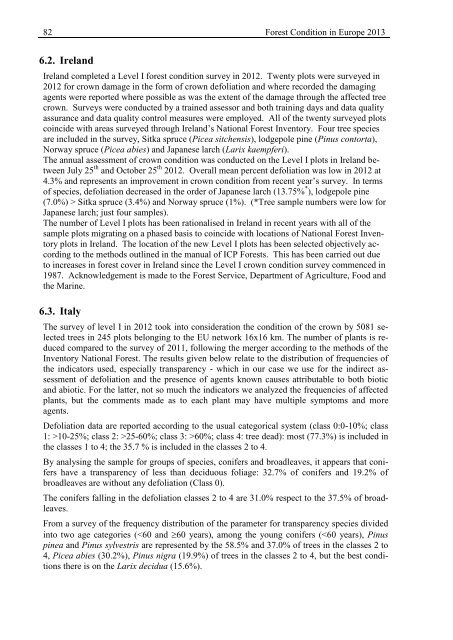Forest Condition in Europe - ICP Forests
Forest Condition in Europe - ICP Forests
Forest Condition in Europe - ICP Forests
Create successful ePaper yourself
Turn your PDF publications into a flip-book with our unique Google optimized e-Paper software.
82 <strong>Forest</strong> <strong>Condition</strong> <strong>in</strong> <strong>Europe</strong> 2013<br />
6.2. Ireland<br />
Ireland completed a Level I forest condition survey <strong>in</strong> 2012. Twenty plots were surveyed <strong>in</strong><br />
2012 for crown damage <strong>in</strong> the form of crown defoliation and where recorded the damag<strong>in</strong>g<br />
agents were reported where possible as was the extent of the damage through the affected tree<br />
crown. Surveys were conducted by a tra<strong>in</strong>ed assessor and both tra<strong>in</strong><strong>in</strong>g days and data quality<br />
assurance and data quality control measures were employed. All of the twenty surveyed plots<br />
co<strong>in</strong>cide with areas surveyed through Ireland’s National <strong>Forest</strong> Inventory. Four tree species<br />
are <strong>in</strong>cluded <strong>in</strong> the survey, Sitka spruce (Picea sitchensis), lodgepole p<strong>in</strong>e (P<strong>in</strong>us contorta),<br />
Norway spruce (Picea abies) and Japanese larch (Larix kaempferi).<br />
The annual assessment of crown condition was conducted on the Level I plots <strong>in</strong> Ireland between<br />
July 25 th and October 25 th 2012. Overall mean percent defoliation was low <strong>in</strong> 2012 at<br />
4.3% and represents an improvement <strong>in</strong> crown condition from recent year’s survey. In terms<br />
of species, defoliation decreased <strong>in</strong> the order of Japanese larch (13.75% * ), lodgepole p<strong>in</strong>e<br />
(7.0%) > Sitka spruce (3.4%) and Norway spruce (1%). (*Tree sample numbers were low for<br />
Japanese larch; just four samples).<br />
The number of Level I plots has been rationalised <strong>in</strong> Ireland <strong>in</strong> recent years with all of the<br />
sample plots migrat<strong>in</strong>g on a phased basis to co<strong>in</strong>cide with locations of National <strong>Forest</strong> Inventory<br />
plots <strong>in</strong> Ireland. The location of the new Level I plots has been selected objectively accord<strong>in</strong>g<br />
to the methods outl<strong>in</strong>ed <strong>in</strong> the manual of <strong>ICP</strong> <strong>Forest</strong>s. This has been carried out due<br />
to <strong>in</strong>creases <strong>in</strong> forest cover <strong>in</strong> Ireland s<strong>in</strong>ce the Level I crown condition survey commenced <strong>in</strong><br />
1987. Acknowledgement is made to the <strong>Forest</strong> Service, Department of Agriculture, Food and<br />
the Mar<strong>in</strong>e.<br />
6.3. Italy<br />
The survey of level I <strong>in</strong> 2012 took <strong>in</strong>to consideration the condition of the crown by 5081 selected<br />
trees <strong>in</strong> 245 plots belong<strong>in</strong>g to the EU network 16x16 km. The number of plants is reduced<br />
compared to the survey of 2011, follow<strong>in</strong>g the merger accord<strong>in</strong>g to the methods of the<br />
Inventory National <strong>Forest</strong>. The results given below relate to the distribution of frequencies of<br />
the <strong>in</strong>dicators used, especially transparency - which <strong>in</strong> our case we use for the <strong>in</strong>direct assessment<br />
of defoliation and the presence of agents known causes attributable to both biotic<br />
and abiotic. For the latter, not so much the <strong>in</strong>dicators we analyzed the frequencies of affected<br />
plants, but the comments made as to each plant may have multiple symptoms and more<br />
agents.<br />
Defoliation data are reported accord<strong>in</strong>g to the usual categorical system (class 0:0-10%; class<br />
1: >10-25%; class 2: >25-60%; class 3: >60%; class 4: tree dead): most (77.3%) is <strong>in</strong>cluded <strong>in</strong><br />
the classes 1 to 4; the 35.7 % is <strong>in</strong>cluded <strong>in</strong> the classes 2 to 4.<br />
By analys<strong>in</strong>g the sample for groups of species, conifers and broadleaves, it appears that conifers<br />
have a transparency of less than deciduous foliage: 32.7% of conifers and 19.2% of<br />
broadleaves are without any defoliation (Class 0).<br />
The conifers fall<strong>in</strong>g <strong>in</strong> the defoliation classes 2 to 4 are 31.0% respect to the 37.5% of broadleaves.<br />
From a survey of the frequency distribution of the parameter for transparency species divided<br />
<strong>in</strong>to two age categories (
















